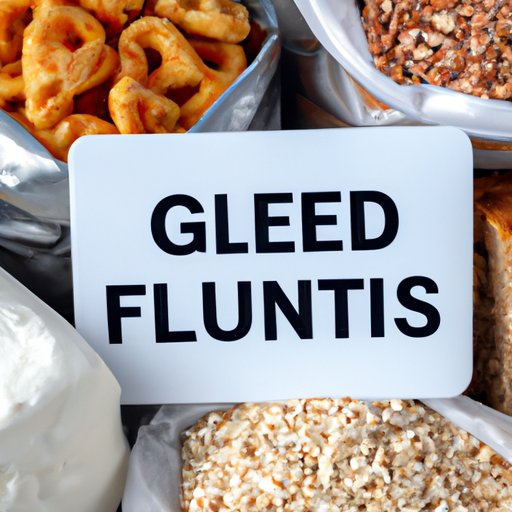
Introduction
Gluten is a protein found in wheat, rye, and barley. For those who are sensitive to gluten or suffer from celiac disease, consuming these grains can cause serious health problems. As a result, gluten-free foods have become increasingly popular in recent times. In this article, we will provide a comprehensive guide to gluten-free foods, including what foods are gluten-free, hidden sources of gluten, gluten-free substitutes, and more.
A Comprehensive Guide to Gluten-Free Foods
Let’s start with the basics. Here are some common gluten-free grains:
- Rice
- Quinoa
- Corn
- Buckwheat
For those who love fruits and veggies, these are naturally gluten-free:
- Apples
- Bananas
- Carrots
- Cucumbers
- Kale
If you’re looking for protein, these meats are gluten-free:
- Beef
- Chicken
- Fish
- Lamb
- Turkey
Dairy products that are gluten-free include:
- Milk
- Cheese
- Yogurt
- Butter
There are also a variety of other food options that are gluten-free, including nuts, seeds, and legumes.
Hidden Sources of Gluten in Foods
Contrary to popular belief, gluten can be found in more than just bread. It can be hidden in a variety of foods, such as:
- Soy sauce
- Beer
- Cereals
- Sausages
That’s why it’s so important to read food labels carefully. Look for anything that contains wheat, rye, or barley. A product may say “wheat-free” but still contain gluten, so be sure to check for all three grains.
Another crucial aspect of avoiding gluten is preventing cross-contamination. This happens when gluten-free foods are prepared with utensils or equipment that have come in contact with gluten-containing foods. To avoid cross-contamination, consider investing in separate kitchen items for gluten-free foods or wash utensils and equipment thoroughly before use.
Gluten-Free on a Budget
Gluten-free living can get expensive, but it doesn’t have to be. Here are some tips for shopping gluten-free on a budget:
- Buy gluten-free items in bulk.
- Shop at farmers’ markets for fresh produce. They offer organic products at a much cheaper price.
- Make your own gluten-free foods like bread, pizza, and granola bars.
- Shop for inexpensive brands and alternatives, such as brown rice pasta instead of wheat pasta.
Here are some simple and inexpensive gluten-free meals:
- Stir-fry with rice, vegetables, and chicken
- Potato and vegetable frittata
- Chili with beans and ground turkey
- Quinoa salad with veggies and feta cheese
Gluten-Free Restaurant Survival Guide
Going out to eat can be daunting for those who follow a gluten-free diet, but it doesn’t have to be this way. Here are some tips on how to eat out while avoiding gluten:
- Research restaurants ahead of time and look for gluten-free options on their menu
- Call ahead and talk to the manager or chef about their gluten-free options
- Communicate your gluten allergy or sensitivity to your server and ask them to inform the chef
- Avoid cross-contamination by asking for your food to be cooked on a separate grill or using separate utensils
When it comes to restaurant types, ethnic restaurants like Thai, Indian, or Mexican are good choices for gluten-free options, as they often use rice instead of wheat or have corn-based dishes. You also may want to avoid fast food restaurants, as their food is often heavily processed and not gluten-free friendly.
Gluten-Free Substitutes
Switching to a gluten-free diet may mean giving up wheat flour, bread, pasta, and crackers, but there are plenty of alternatives to choose from:
- Almond and coconut flour
- Brown rice pasta
- Potato or corn starch
- Gluten-free bread, crackers, and tortillas
Baking with gluten-free ingredients can also be a bit tricky. Here are some tips:
- Use xanthan gum or similar binders to mimic gluten in baked goods
- Experiment with different blends of non-wheat flours
When shopping for gluten-free ingredients, look for trusted brands like Bob’s Red Mill or King Arthur Flour.
Conclusion
Living gluten-free may seem intimidating at first, but with some effort and knowledge, it can become second nature. In this guide, we’ve provided you with all the information you need to know about gluten-free foods, hidden sources of gluten, gluten-free substitutes, and more. It’s important to understand the importance of gluten-free foods for people with gluten sensitivities, and now with the increasing number of gluten-free options on the market, there’s no excuse not to give it a try.





